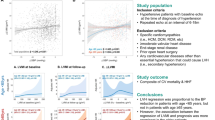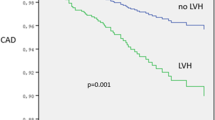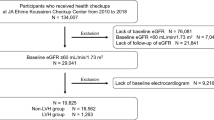Abstract
The electrocardiogram (ECG) is widely used for detection of left ventricular hypertrophy (LVH). However, whether changes in ECG LVH during antihypertensive therapy predict changes in LV mass remains unclear. Baseline and year-1 ECGs and echocardiograms were assessed in 584 hypertensive patients with ECG LVH by Sokolow–Lyon or Cornell voltage–duration product criteria at entry into the Losartan Intervention For Endpoint reduction in hypertension (LIFE) echocardiographic substudy. A ⩾25% decrease in Cornell product defined regression of ECG LVH; a <25% decrease defined no significant regression; and an increase defined progression of ECG LVH. Regression of echocardiographic LVH was defined by a ⩾20% reduction in LV mass. After 1 year of therapy, 155 patients (27%) had regression of ECG LVH, 286 (49%) had no significant change, and 143 (25%) had progression of ECG LVH. Compared with patients with progression of ECG LVH, patients with no significant decrease and patients with regression of ECG LVH had stepwise greater absolute decreases in LV mass (−16±33 vs −29±37 vs −32±41 g, P<0.001), greater percent reductions in LV mass (−5.7±14.6 vs −11.3±13.6 vs −12.3±15.6%, P<0.001), and were more likely to decrease LV mass by ⩾20% (11.2 vs 24.8 vs 36.1%, P<0.001), even after adjusting for possible effects of baseline and change in systolic and diastolic pressures. Compared with progression of ECG LVH, regression of the Cornell product ECG LVH is associated with greater reduction in LV mass and a greater likelihood of regression of anatomic LVH.
This is a preview of subscription content, access via your institution
Access options
Subscribe to this journal
Receive 12 digital issues and online access to articles
$119.00 per year
only $9.92 per issue
Buy this article
- Purchase on Springer Link
- Instant access to full article PDF
Prices may be subject to local taxes which are calculated during checkout

Similar content being viewed by others
References
Verdecchia P et al. Prognostic value of a new electrocardiographic method for diagnosis of left ventricular hypertrophy in essential hypertension. J Am Coll Cardiol 1998; 31: 383–390.
Levy D et al. Prognostic implications of baseline electrocardiographic features and their serial changes in subjects with left ventricular hypertrophy. Circulation 1994; 90: 1786–1793.
Mathew J et al. Reduction of cardiovascular risk by regression of electrocardiographic markers of left ventricular hypertrophy by the angiotensin-converting enzyme inhibitor ramipril. Circulation 2001; 104: 1615–1621.
Verdecchia P et al. Prognostic significance of serial changes in left ventricular mass in essential hypertension. Circulation 1998; 97: 48–54.
Koren MJ et al. Relation of left ventricular mass and geometry to morbidity and mortality in uncomplicated essential hypertension. Ann Intern Med 1991; 114: 345–352.
Levy D et al. Prognostic implications of echocardiographically determined left ventricular mass in the Framingham Heart Study. N Engl J Med 1990; 322: 1561–1566.
Liao Y et al. The relative effects of left ventricular hypertrophy, coronary artery disease, and ventricular dysfunction on survival among black adults. JAMA 1995; 273: 1592–1597.
Schillaci G et al. Continuous relation between left ventricular mass and cardiovascular risk in essential hypertension. Hypertension 2000; 35: 580–586.
Dahlöf B, Pennert K, Hansson L . Reversal of left ventricular hypertrophy in hypertensive patients. A metaanalysis of 109 treatment studies. Am J Hypertens 1992; 5: 95–110.
Schlaich MP, Schmieder RE . Left ventricular hypertrophy and its regression: pathophysiology and therapeutic approach: focus on treatment by antihypertensive agents. Am J Hypertens 1998; 11: 1394–1404.
Neaton JD et al. Treatment of mild hypertension study. Final results. Treatment of Mild Hypertension Study Research Group. JAMA 1993; 270: 713–724.
Five-year findings of the Hypertension Detection and Follow-up Program. Prevention and reversal of left ventricular hypertrophy with antihypertensive drug therapy. Hypertension Detection and Follow-up Program Cooperative Group. Hypertension 1985; 7: 105–112.
Prineas RJ et al. Independent risk for cardiovascular disease predicted by modified continuous score electrocardiographic criteria for 6-year incidence and regression of left ventricular hypertrophy among clinically disease free men: 16-year follow-up for the multiple risk factor intervention trial. J Electrocardiol 2001; 34: 91–101.
Sokolow M, Lyon TP . The ventricular complex in left ventricular hypertrophy as obtained by unipolar precordial and limb leads. Am Heart J 1949; 37: 161–186.
Casale PN et al. Electrocardiographic detection of left ventricular hypertrophy: development and prospective validation of improved criteria. J Am Coll Cardiol 1985; 6: 572–580.
Casale PN et al. Improved sex-specific criteria of left ventricular hypertrophy for clinical and computer interpretation of electrocardiograms: validation with autopsy findings. Circulation 1987; 75: 565–572.
Molloy TJ, Okin PM, Devereux RB, Kligfield P . Electrocardiographic detection of left ventricular hypertrophy by the simple QRS voltage–duration product. J Am Coll Cardiol 1992; 20: 1180–1186.
Okin PM, Roman MJ, Devereux RB, Kligfield P . Electrocardiographic identification of increased left ventricular mass by simple voltage–duration products. J Am Coll Cardiol 1995; 25: 417–423.
Okin PM et al. Time–voltage QRS area of the 12-lead electrocardiogram: detection of left ventricular hypertrophy. Hypertension 1998; 31: 937–942.
Levy D et al. Determinants of sensitivity and specificity of electrocardiographic criteria for left ventricular hypertrophy. Circulation 1990; 81: 815–820.
Dahlöf B et al. The Losartan Intervention For Endpoint reduction (LIFE) in Hypertension study: rationale, design, and methods. The LIFE Study Group. Am J Hypertens 1997; 10: 705–713.
Dahlöf B et al. Characteristics of 9194 patients with left ventricular hypertrophy: the LIFE study. Losartan Intervention For Endpoint Reduction in Hypertension. Hypertension 1998; 32: 989–997.
Kjeldsen SE et al. Lowering of blood pressure and predictors of response in patients with left ventricular hypertrophy: the LIFE Study. Losartan Intervention For Endpoint. Am J Hypertens 2000; 13: 899–906.
Wachtell K et al. Impact of different partition values on prevalences of left ventricular hypertrophy and concentric geometry in a large hypertensive population: the LIFE study. Hypertension 2000; 35: 6–12.
Ditchey RV, Schuler G, Peterson KL . Reliability of echocardiographic and electrocardiographic parameters in assessing serial changes in left ventricular mass. Am J Med 1981; 70: 1042–1050.
Crow RS, Hannan P, Grandits G, Liebson P . Is the echocardiogram an appropriate ECG validity standard for the detection and change in left ventricular size? J Electrocardiol 1996; 29(Suppl): 248–255.
Schillaci G et al. Improved electrocardiographic diagnosis of left ventricular hypertrophy. Am J Cardiol 1994; 74: 714–719.
Norman Jr. JE, Levy D . Improved electrocardiographic detection of echocardiographic left ventricular hypertrophy: results of a correlated data base approach. J Am Coll Cardiol 1995; 26: 1022–1029.
Oikarinen L et al. Relation of QT interval and QT dispersion to echocardiographic left ventricular hypertrophy and geometric pattern in hypertensive patients. The LIFE study. The Losartan Intervention For Endpoint Reduction. J Hypertens 2001; 19: 1883–1891.
Farb A, Devereux RB, Kligfield P . Day-to-day variability of voltage measurements used in electrocardiographic criteria for left ventricular hypertrophy. J Am Coll Cardiol 1990; 15: 618–623.
Willems JL, Poblete PF, Pipberger HV . Day-to-day variation of the normal orthogonal electrocardiogram and vectorcardiogram. Circulation 1972; 45: 1057–1064.
Zhou SH et al. Improved ECG models for estimation of left ventricular hypertrophy progression and regression incidence by redefinition of the criteria for a significant change in left ventricular hypertrophy status. The MRFIT Research Group. Multiple Risk Factor Intervention Trial. J Electrocardiol 1993; 26(Suppl): 108–113.
Davis CE . The effect of regression to the mean in epidemiologic and clinical studies. Am J Epidemiol 1976; 104: 493–498.
Palmieri V et al. Reliability of echocardiographic assessment of left ventricular structure and function: the PRESERVE study. Prospective Randomized Study Evaluating Regression of Ventricular Enlargement. J Am Coll Cardiol 1999; 34: 1625–1632.
Devereux RB et al. Echocardiographic assessment of left ventricular hypertrophy: comparison to necropsy findings. Am J Cardiol 1986; 57: 450–458.
Acknowledgements
We thank Paulette A Lyle for assistance with preparation of the manuscript. This work is supported in part by Grant COZ-368 from Merck & Co., Inc., West Point, PA, USA.
Author information
Authors and Affiliations
Consortia
Corresponding author
Rights and permissions
About this article
Cite this article
Okin, P., Devereux, R., Liu, J. et al. Regression of electrocardiographic left ventricular hypertrophy predicts regression of echocardiographic left ventricular mass: the LIFE study. J Hum Hypertens 18, 403–409 (2004). https://doi.org/10.1038/sj.jhh.1001707
Published:
Issue Date:
DOI: https://doi.org/10.1038/sj.jhh.1001707
Keywords
This article is cited by
-
Clinical impact of skin autofluorescence on high-sensitivity troponin T in hypertensive patients
Clinical Hypertension (2017)
-
Relationships between the arterial velocity pulse index as a novel marker of atherosclerosis and biomarkers of cardiac or renal condition in patients with type 2 diabetes mellitus
Diabetology International (2017)
-
Does Cardiovascular Ultrasound Have a Role in Assessment of Cardiovascular Risk in Asymptomatic Persons?
Current Cardiovascular Risk Reports (2012)
-
Changes in electrocardiographic left ventricular hypertrophy and risk of major cardiovascular events in isolated systolic hypertension: The LIFE study
Journal of Human Hypertension (2011)



